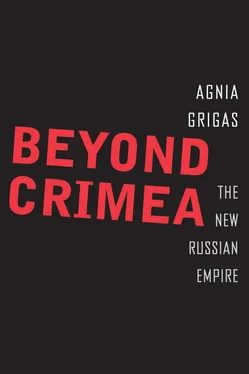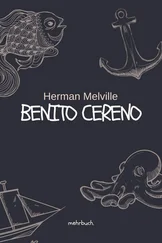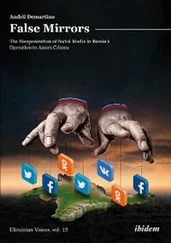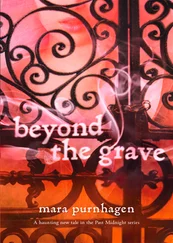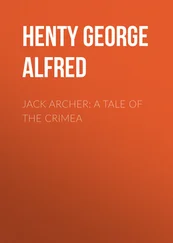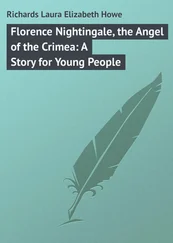12. Sherr, Hard Diplomacy and Soft Coercion , p. 87.
13. Almanaque Mundial 1996 (Mexico City: Editorial América/Televisa, 1995), pp. 548–52.
14. Hilary Pilkington, Migration, Displacement, and Identity in Post-Soviet Russia (London: Routledge, 1998), p. 3.
15. Fiona Hill, “Russia’s Newly Found ‘Soft Power,’” Brookings, 26 August 2004, http://www.brookings.edu/research/articles/2004/08/26russia-hill.
16. Sherr, Hard Diplomacy and Soft Coercion , p. 90.
17. Marek Menkiszak, “The Putin Doctrine: The Formation of a Conceptual Framework for Russian Dominance in the Post-Soviet Area,” OSW Commentary , no. 131 (28 March 2014): 2, http://www.osw.waw.pl/sites/default/files/commentary_131.pdf.
18. Evgeny Verlin, “An Enormous Amount of Work Lies Ahead of Us…,” Russkiy Mir Journal (January 2010); Lada Korotun, “Russia to Help Its Compatriots with Words and Deeds,” The Voice of Russia, http://sputniknews.com/voiceofrussia/2011/04/21/49267112/.
19. “Russkiy yazyk ukreplyaet svoi pozitsii v Gruzii,” MSRS, 18 February 2014, http://www.msrs.ru/ournews/2014-02-11; Valeri Bukhalov and Yakov Pliner, “My blagodarny fondu ‘Russkiy Mir,’” Delfi, 23 March 2012, http://rus.delfi.lv/news/daily/versions/valerij-buhvalov-yakov-pliner-my-blagodarny-fondu-russkij-mir.d?id=42229746.
20. See Michael Gorham, “Virtual Russophobia: Language Policy as ‘Soft Power’ in the New Media Age,” Digital Icons: Studies in Russian, Eurasian and Central European New Media , no. 5 (2011): 30–31; Ilya Azar, “Yazyk Kremlya,” Gazeta.ru, 25 June 2007, www.gazeta.ru/2007/06/25/oa_242691.shtml.
21. Heather A. Conley and Theodore P. Gerber, Russian Soft Power in the 21st Century: An Examination of Russian Compatriot Policy in Estonia (Washington, DC: Center for Strategic and International Studies, 2011), p. 13.
22. Tony Halpin, “Russian Orthodox Church Chooses Between ‘Ex-KGB Candidates’ as Patriarch,” The Times (London), 26 January 2009, http://www.thetimes.co.uk/tto/faith/article2100100.ece.
23. “Russian Patriarch Calls Putin Era ‘Miracle of God,’” Reuters, 8 February 2012, http://uk.reuters.com/article/2012/02/08/uk-russia-putin-religion-idUKTRE81722Y20120208.
24. “Patriarch Kirill: Russian World—A Special Civilization, Which Should Be Protected,” newschurch.name, 9 September 2014, http://www.newschurch.name/news/christian-churhes-eastern-europe/patriarch-kirill-russian-world-a-special-civilization-which-should-be-protected/.
25. “Russia’s Patriarch Kirill Given Toy Fighter Jet by Factory Workers,” Moscow Times , 17 September 2014, http://www.themoscowtimes.com/news/article/russia-s-patriarch-kirill-given-fighter-jet-by-factory-workers/507270.html.
26. Thomas de Waal, “Spring for the Patriarchs,” The National Interest , 27 January 2011, cited in Sherr, Hard Diplomacy and Soft Coercion , p. 89.
27. According to a new Pew Research Center analysis of three sets of data (1991, 1998, and 2008) from the International Social Survey Programme (ISSP), “Russians Return to Religion, But Not to Church,” Pew Research Center, http://www.pewforum.org/2014/02/10/russians-return-to-religion-but-not-to-church/.
28. “Russkaya tserkov’ оb’edinyaet svyshe 150 mln. veruyushchikh v bolee chem 60 stranah—mitropolit Illarion,” Interfax Religiya, 2 March 2011, http://www.interfax-religion.ru/?act=news&div=39729.
29. Russia, Ministry of Foreign Affairs, “A Survey of Russian Federation Foreign Policy,” http://www.mid.ru/brp_4.nsf/e78a48070f128a7b43256999005bcbb3/89a30b3a6b65b4f2c32572d700292f74?OpenDocument; and “Osnovnye napravleniya politiki Rossiyskoy Federatsii v sfere mezhdunarodnogo kul’turno-gumanitarnogo sotrudnichestva,” http://www.mid.ru/bdomp/ns-osndoc.nsf/e2f289bea62097f9c325787a0034c255/fd3aa5ccb0c5f96b442579ec004ec849%21OpenDocument.
30. Pelnēns, The “Humanitarian Dimension” of Russian Foreign Policy , p. 19.
31. Ibid, pp. 22–23; Devon Curtis, “Politics and Humanitarian Aid: Debates, Dilemmas and Dissension,” HPG Report 10 (April 2001), http://www.odi.org/sites/odi.org.uk/files/odi-assets/publications-opinion-files/295.pdf.
32. Jonathan Daniel Weiler, Human Rights in Russia—A Darker Side of Reform (Boulder: Lynne Rienner, 2004), pp. 3–22.
33. Pelnēns, The “Humanitarian Dimension” of Russian Foreign Policy , p. 22.
34. Ibid.
35. Ibid, p. 23.
36. Menkiszak, “The Putin Doctrine,” pp. 5–6.
37. Ibid, p. 22.
38. Mitchell A. Orenstein, “Putin’s Western Allies: Why Europe’s Far Right Is on the Kremlin’s Side,” Foreign Affairs , 25 March 2014, http://www.foreignaffairs.com/articles/141067/mitchell-a-orenstein/putins-western-allies.
39. “Putin: Ukrainian Soldiers Like Nazis in Leningrad,” Times of Israel , 29 August 2014, http://www.timesofisrael.com/putin-ukrainian-soldiers-like-nazis-in-leningrad/.
40. “Ukraine Run by ‘Miserable’ Jews: Rebel Chief,” Yahoo! News, 2 February 2015, http://news.yahoo.com/ukraine-run-miserable-jews-rebel-chief-202600090.html.
41. Agnia Grigas and Marcel van Herpen, “The Media Has Swallowed Five Russian Myths That Have Helped Putin Win In Ukraine,” Forbes.com, 17 September 2014, http://www.forbes.com/sites/realspin/2014/09/17/the-media-has-swallowed-five-russian-myths-that-have-helped-putin-win-in-ukraine/.
42. Sinikukka Saari, Promoting Democracy and Human Rights in Russia (London: Routledge, 2004), pp. 21–32.
43. “Russian Minorities in the Former Soviet Union,” http://folk.uio.no/palk/PRIO%20Diaspora.htm; Olga Zurjari-Ossipova, “Human Rights As the Political-Juridical Issues of the Estonian-Russian Inter-State Relations” (NATO Research Fellowships Programme paper, June 1997), http://www.nato.int/acad/fellow/95-97/zurjari.pdf, pp. 18–22.
44. Ibid.
45. Natalya Kanevskaya, “How The Kremlin Wields Its Soft Power In France,” Radio Free Europe/Radio Liberty, 3 November 2014, http://www.rferl.org/content/russia-soft-power-france/25433946.html.
46. Institute For Democracy and Cooperation, http://www.indemco.org/index.php?id=2&language=2.
47. Institut de la Démocratie et de la Coopération, http://www.idc-europe.org/en/The-Institute-of-Democracy-and-Cooperation.
48. Ibid.
49. Pelnēns, The “Humanitarian Dimension” of Russian Foreign Policy , p. 20.
50. “Rossotrudnichestvo to Open Offices in Over 100 Countries—Kosachev,” Tass, 24 April 2012, http://tass.com/en/archive/674112.
51. “New Agreement with Rossotrudnichestvo to Strengthen HSE’s Presence in Europe,” Higher School of Economics (HSE), 7 November 2014, http://www.hse.ru/en/news/edu/136894039.html; “Russia Wants ‘Unbiased Attitude’—Agency Head,” Sputnik International, 3 September 2012, http://sputniknews.com/politics/20120903/175734669.html.
52. “Russia’s Soft-Power Agency Is Allocated More Funds,” Sputnik, 24 July 2013, http://sputniknews.com/russia/20130724/182398836/Russias-Soft-Power-Agency-Is-Allocated-More-Funds.html.
53. Clifford J. Levy, “Moscow’s Mayor Exports Russia’s New Nationalism,” New York Times, 25 October 2008, http://www.nytimes.com/2008/10/26/world/europe/26mayor.html?pagewanted=all.
54. Moscow City Government, Department for Foreign Economic Activity and International Relations, http://www.mos.ru/en/authority/mir/.
55. Jackie Gower and Graham Timmins, eds., Russia and Europe in the Twenty-First Century—An Uneasy Partnership (London: Anthem Press, 2007), pp. 80–81.
56. Tatyana Kiilo and Yelena Vladimirova, “Compatriots,” Russian Federation 2011: Short Term Prognosis , ed. Karmo Tüür (Tartu: Tartu University Press, 2011), p. 181.
Читать дальше
